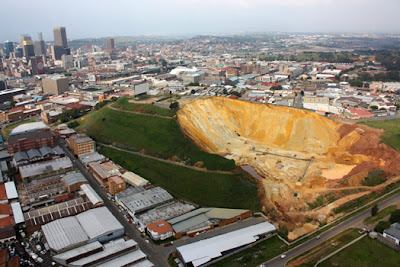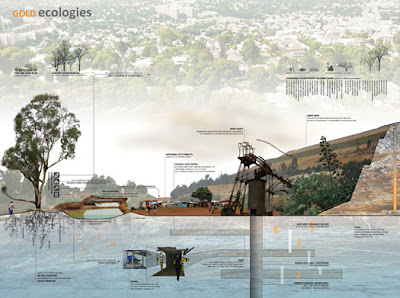Brilliant study of the meshing of urbanization and gold mining in Johannesburg, South Africa by Dorothy Tang and Andrew Watkins (on Design Observer). As mentioned in the article and accompanying photo essay; “ In particular, the 80-kilometer mining belt between the two cities is riddled by deep-shaft mines, where companies built an extensive network of underground tunnels and moved large amounts of earth to the surface. These operations have weakened geological strata, disrupted natural drainage patterns and altered ecological habitat. The original semi-arid grasslands ecology is now converted to an urban forest, and sediment from mining waste has blocked natural waterways, unexpectedly creating wetlands with rich bird habitat.“
While mining and urban areas is not necessarily a different scenario (the many sand and gravel pits around cities have a similar pattern) – the cyanide-extraction method of gold mines makes them especially toxic neighbors – especially when coupled with adjacent areas of poverty. The overall urban pattern that emerges pairs the informal settlements with gold mining particularly on the fringes of the urban area.
Some of the diagrams show the processes of mining on a macro and site specific scale – which is helpful for understanding the complexities of the process.
In addition to analysis, there is thought of opportunities and solutions that take advantage of these new ecologies that have emerged – as Tang & Watkins propose: “While Johannesburg and Ekurhuleni face grave environmental challenges, including contaminated soils, acid mine drainage, undermined land and scarce water resources, it is also important to recognize the possibilities found in the existing regional infrastructure of pipelines and the large quantities of land being released for use. Currently operating gold mining companies recognize the environmental challenges they face and are actively pursuing more sustainable mining practices. Informal settlements are finding productive political strategies and are maintaining a positive entrepreneurial nature. The scarce water resources of the Witwatersrand are a critical entry point for landscape interventions, especially in relation to the provision of sanitation and the remediation of acid mine drainage. Can gold mining and informal settlements, two seemingly disparate players in the region, provide solutions for the future development of the “Ridge of White Waters”?
Read much more and see the entire slideshow here.





